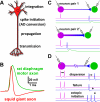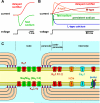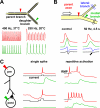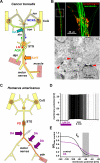Beyond faithful conduction: short-term dynamics, neuromodulation, and long-term regulation of spike propagation in the axon
- PMID: 21708220
- PMCID: PMC3156869
- DOI: 10.1016/j.pneurobio.2011.06.001
Beyond faithful conduction: short-term dynamics, neuromodulation, and long-term regulation of spike propagation in the axon
Abstract
Most spiking neurons are divided into functional compartments: a dendritic input region, a soma, a site of action potential initiation, an axon trunk and its collaterals for propagation of action potentials, and distal arborizations and terminals carrying the output synapses. The axon trunk and lower order branches are probably the most neglected and are often assumed to do nothing more than faithfully conducting action potentials. Nevertheless, there are numerous reports of complex membrane properties in non-synaptic axonal regions, owing to the presence of a multitude of different ion channels. Many different types of sodium and potassium channels have been described in axons, as well as calcium transients and hyperpolarization-activated inward currents. The complex time- and voltage-dependence resulting from the properties of ion channels can lead to activity-dependent changes in spike shape and resting potential, affecting the temporal fidelity of spike conduction. Neural coding can be altered by activity-dependent changes in conduction velocity, spike failures, and ectopic spike initiation. This is true under normal physiological conditions, and relevant for a number of neuropathies that lead to abnormal excitability. In addition, a growing number of studies show that the axon trunk can express receptors to glutamate, GABA, acetylcholine or biogenic amines, changing the relative contribution of some channels to axonal excitability and therefore rendering the contribution of this compartment to neural coding conditional on the presence of neuromodulators. Long-term regulatory processes, both during development and in the context of activity-dependent plasticity may also affect axonal properties to an underappreciated extent.
Copyright © 2011 Elsevier Ltd. All rights reserved.
Figures















Similar articles
-
Autonomous initiation and propagation of action potentials in neurons of the subthalamic nucleus.J Physiol. 2008 Dec 1;586(23):5679-700. doi: 10.1113/jphysiol.2008.155861. Epub 2008 Oct 2. J Physiol. 2008. PMID: 18832425 Free PMC article.
-
Action potential initiation and propagation in rat neocortical pyramidal neurons.J Physiol. 1997 Dec 15;505 ( Pt 3)(Pt 3):617-32. doi: 10.1111/j.1469-7793.1997.617ba.x. J Physiol. 1997. PMID: 9457640 Free PMC article.
-
Neuronal excitability: voltage-dependent currents and synaptic transmission.J Clin Neurophysiol. 1992 Apr;9(2):195-211. J Clin Neurophysiol. 1992. PMID: 1375602 Review.
-
Active action potential propagation but not initiation in thalamic interneuron dendrites.J Neurosci. 2011 Dec 14;31(50):18289-302. doi: 10.1523/JNEUROSCI.4417-11.2011. J Neurosci. 2011. PMID: 22171033 Free PMC article.
-
Gating of action potential propagation by an axonal A-like potassium conductance in the hippocampus: a new type of non-synaptic plasticity.J Physiol Paris. 1999 Sep-Oct;93(4):285-96. doi: 10.1016/s0928-4257(00)80057-1. J Physiol Paris. 1999. PMID: 10574118 Review.
Cited by
-
The Site of Spontaneous Ectopic Spike Initiation Facilitates Signal Integration in a Sensory Neuron.J Neurosci. 2016 Jun 22;36(25):6718-31. doi: 10.1523/JNEUROSCI.2753-15.2016. J Neurosci. 2016. PMID: 27335403 Free PMC article.
-
Spatiotemporal model of tripartite synapse with perinodal astrocytic process.J Comput Neurosci. 2020 Feb;48(1):1-20. doi: 10.1007/s10827-019-00734-4. Epub 2019 Dec 3. J Comput Neurosci. 2020. PMID: 31797200
-
Targeting papez circuit for cognitive dysfunction- insights into deep brain stimulation for Alzheimer's disease.Heliyon. 2024 Apr 30;10(9):e30574. doi: 10.1016/j.heliyon.2024.e30574. eCollection 2024 May 15. Heliyon. 2024. PMID: 38726200 Free PMC article. Review.
-
Deep brain stimulation: current challenges and future directions.Nat Rev Neurol. 2019 Mar;15(3):148-160. doi: 10.1038/s41582-018-0128-2. Nat Rev Neurol. 2019. PMID: 30683913 Free PMC article. Review.
-
What are the mechanisms for analogue and digital signalling in the brain?Nat Rev Neurosci. 2013 Jan;14(1):63-9. doi: 10.1038/nrn3361. Epub 2012 Nov 28. Nat Rev Neurosci. 2013. PMID: 23187813 Review.
References
-
- Alle H, Geiger JR. Combined analog and action potential coding in hippocampal mossy fibers. Science. 2006;311:1290–1293. - PubMed
-
- Alle H, Geiger JR. Analog signalling in mammalian cortical axons. Curr Opin Neurobiol. 2008;18:314–320. - PubMed
-
- Alle H, Roth A, Geiger JR. Energy-efficient action potentials in hippocampal mossy fibers. Science. 2009;325:1405–1408. - PubMed
Publication types
MeSH terms
Substances
Grants and funding
LinkOut - more resources
Full Text Sources

